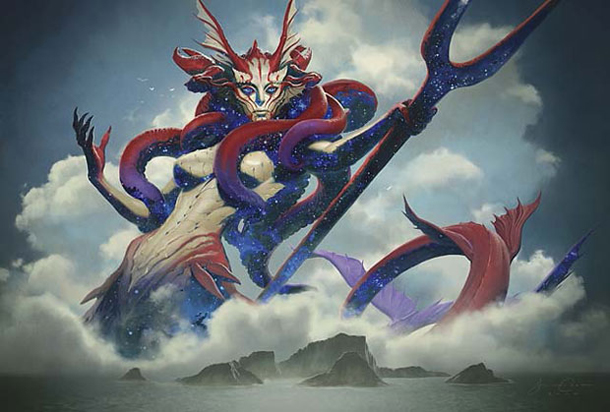Theros Previews: Thassa, God of the Sea; Ember Swallower; and More!
by: CML
After a long, hot, wet American summer, the too-long Standard season has changed into a better season — Theros spoiler season! Though I haven’t been this eager for a new set since I was a kid, there’s something about big sets that’s always exciting.
In recent years, Innistrad gave us cards like Snapcaster Mage, Delver of Secrets, Geist of Saint Traft, Past in Flames, and Liliana of the Veil, while Return to Ravnica produced Deathrite Shaman, Abrupt Decay, Sphinx’s Revelation, and shocklands halfway between the price point of “old Ravnica duals” and “old Ravnica duals presented by Xerox.”
Here’s why I like Theros so far:
- The art is a beautiful departure from the fanboy-ish / pornographic photorealism that’s been the main style since Shards of Alara. Yes, bad art is a part of New World Order, too.
- The card frames are about as good as it gets without, you know, returning to the old one.
- It is possible that, come October, the new Legend rule will go from “irredeemably godawful” to “merely horrendous.”
- Sword-and-sandal and sword-and-sorcery are sweet, but together? A veritable triumvirate. (Back-to-school special: your sexually repressed Latin teacher glossing over the ‘sword-and-sheath’ jokes that every Roman writer made a lot of.)
- I guess the mechanics look fun, too. The incremental advantage from activated abilities makes me slaver like the arriviste reactionary I am. Even if Monstrous really is just a lame version of ROE’s Level Up, Devotion is just a lame version of Eventide’s Chroma, and the reminder text on Bestow has the legal rigor of the Zimmerman jury, it beats Slivers that look as human as Star Trek “aliens.”

“Live long and prosper — don’t be a Magic pro.”
Here’s why you should like Theros:
“Mad Kraken, yo.”
The Shipbreaker is probably too bad for Standard or a regular Cube, but he more than makes up for that in flavor. Pass the Caesar salad, and hold the crab-cracking implements, as he dies to removal just like any Cancrix or Hatchling.

“The Dude Abident.”
On the topic of salad tongs, the Bident seems OK — though the effect was first printed on Coastal Piracy, the new generation that likes stuff like “dudes” and “the combat step” will recognize it from Edric, Ruiner of EDH Games. Artifact and enchantment are two non-interactive card types that, paradoxically, make the Pitchfork easier to kill. I would also like to add that Thassa’s weapon is only two-thirds as cool as the Master of the Pearl Trident’s.

Thassa, God of the Sea 2U
Legendary Enchantment Creature -God M
Indestructible
As long as your devotion to blue is less than five, Thassa isn’t a creature. (Each U in the mana costs of permanents you control adds to your devotion to blue.)
At the beginning of your upkeep, scry 1.
1U: Target creature you control can’t be blocked this turn.
5/5
Cards like this are tough to evaluate, since one has to grasp for precedents, and even then those fail to tell the whole story. My guess is that Thassa isn’t great for Constructed or Cube, since the activated ability is expensive and the Scry 1 trigger is not Dark Confidant or Phyrexian Arena or even Dark Tutelage. I also think we may be underestimating how hard it is to get to five Blue, but pick up a copy and test her! There’s only one way to find out.
“Hungry? Why wait.”
I love Ember Swallower, but I wish they’d costed the Monstrosity activation at six instead. Cubes will not want a 4/5 for 2RR, though he does do a good job of blocking Hellrider, Hero of Oxid Ridge, and Hound of Griselbrand (the Game Triple H’s.)
“The Greeks have gotten less attractive with age — which the pederasts predicted.”
This is another tough card to evaluate. I think they’ll be played a little, but with aggro decks trending towards heavier creature counts and Boros Reckoner already in the three-slot, the potential may be limited. Cubers will enjoy targeting the happy couple with a Flame Jab or Rancor over and over again.
“Satyriasis in men, nymphomania in women …”
The satyr could be abusable, though unlike Burning-Tree Emissary, Lotus Cobra and Priest of Urabrask, he doesn’t leave behind a body (Snapcaster Mage teaches us how potent a 2/1 can be). Also unlike BTE and the Priest, though, he ramps.
“Disco Demolition Night.”
If Smash to Smithereens is played in Legacy, Destructive Revelry can be too. This might be the best Constructed card spoiled so far. Cube curators will have to compare this to Hull Breach, Wear // Tear, Artifact Mutation, and Qasali Pridemage.
“Things have really come to a head.”
Polukranos is my favorite spoiler. The Monstrosity activation will draw comparisons to Bonfire of the Damned and Olivia Voldaren, as well as old-school dumb draft bomb Living Inferno, but Polukranos is much more interesting than those cards. Timing the instant-speed pump correctly will take a lot of judgment and finesse, and it’s nice that after the whole AVR hand-holding soul-bonding no-removal fiasco, Wizards is not afraid to print an ability on a Mythic whose activation could get you blown out.
Thanks for reading. Join me for more previews next week!
CML
